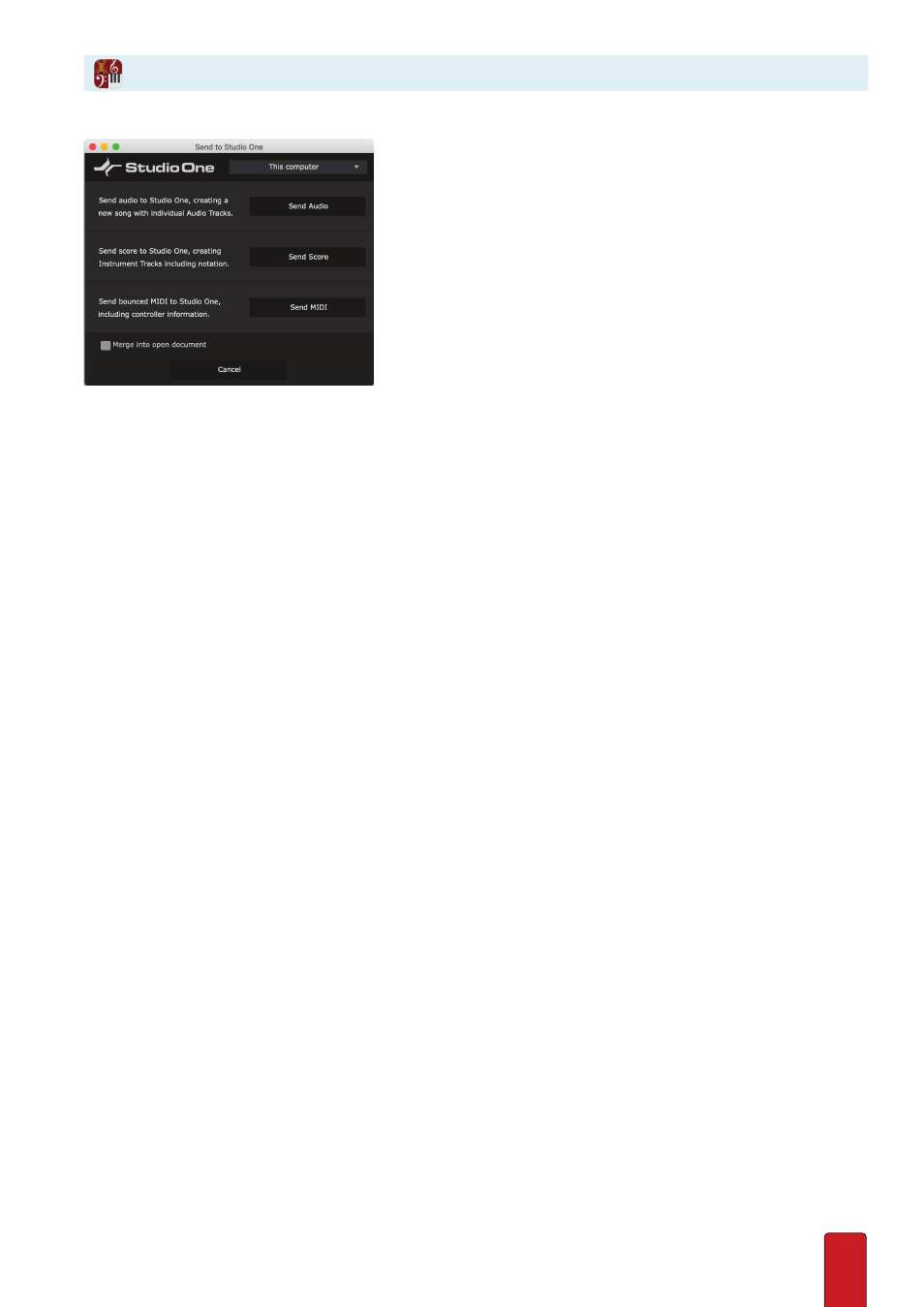Send to studio one: score / midi data – PreSonus Notion 6 - Notation Software (Boxed) User Manual
Page 280

15.8
Send to Studio One from Notion
Do you “think in notation” but need to ultimately use a DAW? Now you can
compose in Notion and then send either score or note data (MIDI and
other note related information) straight over to Studio One - whether it’s
running on the same computer, or to an open instance of Studio One
anywhere on the network .
Send Score if you want to see your notation displayed exactly as is in
Notion, but in Studio One’s Score Editor .
Send MIDI if you want to send all the MIDI generated by Notion’s notation
and any associated Rules you might be using .
File>Send to Studio One dialog, in Notion 6
Send score to Studio One (requires Studio One 5.0 and Notion 6.7 or later*)
1 . Open Studio One either on the same machine, or a machine on the same network
2 . In Notion, go to File>Send to Studio One (or Cmd/Ctrl + Shift + U)
3 . Select whether to merge into an existing song (overwriting a previous transfer) or to create a new document
4 . Click Send Score . Notion will now transfer the score information to Studio One where you can now assign sounds .
5 . Now open the Score Editor in Studio One, and you will see your notation as it was in Notion, and includes:
•
All score display data
•
Transposition
•
Page layout, including page size, margins, notation font size, staff and system spacing
•
File name
•
Tempo track
•
Key signatures, including key changes
6 . Note that repeats and other similar instructions (e .g . DC al Coda) can be seen but are not observed by Studio One - you
may wish to send as bounced MIDI if you want the performance to be ‘unrolled’ to match the tempo track
7 . The score is displayed as is - Studio One’s Score Editor has a smaller feature-set than Notion, so not everything you can
import from Notion is able to be edited in Studio One . (The information is retained so that it can be sent back to Notion
without losing anything - just like the workflow between Notion 6 desktop, and Notion iOS)
7 . If you only want to send a few staves, then select these instruments in the score before opening the Send to Studio One
dialog
*If you ‘Send Score’ to Studio One 4 or earlier, it will send bounced MIDI instead (see below)
Send bounced MIDI to Studio One
1 . Open Studio One either on the same machine, or a machine on the same network
2 . In Notion, go to File>Send to Studio One (or Cmd/Ctrl + Shift + U)
3 . Select whether to merge into an existing song (overwriting a previous transfer) or to create a new document
4 . Notion will now transfer the information to Studio One
5 . In Studio One the document is now ready for you to assign sounds, and retains the following from Notion:
•
Note data (pitch, length, velocity, CC data etc)
•
File name
•
Instrument (score) order
•
Instrument names
•
Tempo track (on initial transfer)
•
Initial metronome mark
•
Key signatures
•
Keyswitches (see
, “sending Note-offs”)
•
VST information - if you have a matching VST enabled in both Notion and Studio One, they will be loaded on
transfer, PLUS, any parameters you have changed will also be sent . Ensure you have the VSTi you are using in
Notion also enabled in Studio One
6 . Note if you open Studio One’s Score Editor, then this will show you Studio One’s conversion of the imported MIDI data
NOT the original score data displayed in the original Notion file . If you want the score displayed as is, use the above ‘Send
Score’ option instead
7 . If you want to send an extract or short idea rather than the whole score, just make a selection in the score first
Send to Studio One: Score / MIDI data